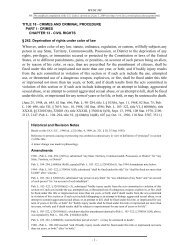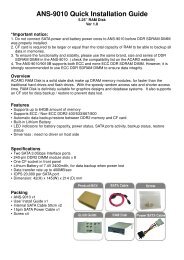2004 Instructions for Form 1040 (ALL) - Supreme Law Firm
2004 Instructions for Form 1040 (ALL) - Supreme Law Firm
2004 Instructions for Form 1040 (ALL) - Supreme Law Firm
Create successful ePaper yourself
Turn your PDF publications into a flip-book with our unique Google optimized e-Paper software.
• The 2002 Tax Rate Schedules on taxable income be<strong>for</strong>e subtracting exemp- his <strong>Form</strong> <strong>1040</strong>, line 38, was a negative<br />
page J-5,<br />
tions shown on your 2003 <strong>Form</strong> <strong>1040</strong>, $1,000). John adds the $3,000 from Sched-<br />
line 38 (or as previously adjusted), was less<br />
• The 2002 Capital Gain Tax Workthan<br />
zero. Enter the amount by which your<br />
ule D, line 18, and the $5,000 carryover. He<br />
sheet on page J-5, or<br />
reduces the result by the $7,000 loss on his<br />
2003 capital loss carryover to <strong>2004</strong> (the Schedule D, line 17a, and enters $1,000 on<br />
• The Schedule D you filed <strong>for</strong> 2002 sum of your short- and long-term capital line 2 of the worksheet.<br />
(but use the 2002 Tax Rate Schedules on loss carryovers) exceeds the excess of the<br />
page J-5 instead of the 2002 Tax Table loss on your 2003 Schedule D, line 17a,<br />
when figuring the tax on Schedule D,<br />
John enters -0- on line 3 of the work-<br />
over the loss on your 2003 Schedule D, line<br />
lines 25 and 39, or on the Schedule D Tax sheet because he does not have an NOL <strong>for</strong><br />
18.<br />
Worksheet, lines 15 and 36).<br />
2003 and did not have an NOL carryover<br />
from 2003 available to carry to <strong>2004</strong> and<br />
Line 3. If you had an NOL <strong>for</strong> 2003, enter<br />
later years. The NOLD <strong>for</strong> 2003 of $2,100<br />
the amount of that NOL as figured on the<br />
2003 <strong>Form</strong> 1045, Schedule A, line 27, you<br />
was reduced to zero because it did not exfiled<br />
with <strong>Form</strong> 1045 or <strong>Form</strong> <strong>1040</strong>X. If<br />
ceed his modified taxable income of<br />
you did not have an NOL <strong>for</strong> 2003, enter<br />
$4,100. Modified taxable income is figured<br />
Line 13<br />
the portion, if any, of the NOL carryovers<br />
by adding back the $3,000 net capital loss<br />
If you used Schedule J to figure your tax <strong>for</strong> and carrybacks to 2003 that were not used<br />
deduction and the $3,050 of exemptions to<br />
2003 (that is, you entered the amount from in 2003 and were carried to years after negative taxable income (figured without<br />
that Schedule J, line 22, on <strong>Form</strong> <strong>1040</strong>, 2003.<br />
regard to the NOLD) of $1,950. John enters<br />
line 41, or on <strong>Form</strong> <strong>1040</strong>X), enter on line<br />
$1,000 on line 4 and $3,050 on line 5. He<br />
13 the amount from that Schedule J, line 3. Example. John Farmington did not use enters $3,050 as a negative amount on<br />
income averaging <strong>for</strong> 2001, 2002, nor Schedule J, line 13. He enters $6,000 on<br />
If you did not use Schedule J to figure 2003. The taxable income be<strong>for</strong>e subyour<br />
tax <strong>for</strong> 2003, enter on line 13 the tax- tracting exemptions on his 2003<br />
ule J, line 15. If he uses Schedule J to figure<br />
Schedule J, line 14, and $2,950 on Schedable<br />
income from your 2003 tax return (or <strong>Form</strong> <strong>1040</strong>, line 38, is a negative $1,000. his tax <strong>for</strong> 2005, he will enter $2,950 on his<br />
as previously adjusted by the IRS, an This amount includes an NOL deduction 2005 Schedule J as his 2003 taxable inamended<br />
return, etc.). But if that amount is (NOLD) on his 2003 <strong>Form</strong> <strong>1040</strong>, line 21, of come <strong>for</strong> income averaging purposes.<br />
zero or less, complete the worksheet below $2,100. The $2,100 is the portion of the<br />
to figure the amount to enter on line 13. 2002 NOL that was remaining from 2001<br />
to be carried to 2003. See the examples that<br />
If you filed your 2003 tax return using<br />
begin on pages J-3 and J-4. A deduction <strong>for</strong> Line 16<br />
TeleFile, enter the taxable income from<br />
exemptions of $3,050 is shown on <strong>Form</strong><br />
your TeleFile Tax Record. If you did not<br />
If line 15 is zero or less, enter -0- on line 16.<br />
<strong>1040</strong>, line 39, and line 40, taxable income,<br />
file a tax return <strong>for</strong> 2003, use the amount<br />
Otherwise, figure the tax on the amount on<br />
is limited to zero. John does not have an<br />
you would have reported as your taxable<br />
line 15 using:<br />
NOL <strong>for</strong> 2003. John subtracts from the<br />
income had you been required to file a tax<br />
$1,000 negative amount on <strong>Form</strong> <strong>1040</strong>, line • The 2003 Tax Rate Schedules on page<br />
return. Be sure to keep all your records <strong>for</strong><br />
38, the $3,050 deduction <strong>for</strong> exemptions. J-7,<br />
2003 until at least 3 years after April 15,<br />
The result is a negative $4,050, John’s<br />
2005 (or the date you file your <strong>2004</strong> tax<br />
• The 2003 Qualified Dividends and<br />
2003 taxable income, which he enters as a<br />
return, if later), even if you did not file a tax<br />
Capital Gain Tax Worksheet on page J-8,<br />
positive amount on line 1 of the 2003 workreturn<br />
<strong>for</strong> 2003.<br />
or<br />
sheet.<br />
• The Schedule D you filed <strong>for</strong> 2003<br />
<strong>Instructions</strong> <strong>for</strong> 2003 Taxable<br />
John had a $3,000 net capital loss de-<br />
(but use the 2003 Tax Rate Schedules on<br />
Income Worksheet<br />
duction on Schedule D, line 18 (which was<br />
page J-7 instead of the 2003 Tax Table<br />
Line 2. Any net capital loss deduction on also entered on <strong>Form</strong> <strong>1040</strong>, line 13a), a<br />
when figuring the tax on Schedule D, lines<br />
your 2003 Schedule D, line 18, is not al- $7,000 loss on Schedule D, line 17a, and a 50 and 52, or on the Schedule D Tax Work-<br />
lowed <strong>for</strong> income averaging purposes to the $5,000 capital loss carryover to <strong>2004</strong> (his sheet, lines 48 and 50).<br />
extent it did not reduce your capital loss 2003 capital loss carryover to <strong>2004</strong> was<br />
carryover to <strong>2004</strong>. This could happen if the $5,000, not $4,000, because the amount on<br />
2003 Taxable Income Worksheet—Line 13 Keep <strong>for</strong> Your Records<br />
Complete this worksheet if your 2003 taxable income is zero or less. See the instructions above be<strong>for</strong>e completing this<br />
worksheet.<br />
1. Figure the taxable income from your 2003 tax return (or as previously adjusted) without limiting it<br />
to zero. If you had an NOL <strong>for</strong> 2003, do not include any NOL carryovers or carrybacks to 2003.<br />
Enter the result as a positive amount ............................................... 1.<br />
2. If there is a loss on your 2003 Schedule D, line 18, add that loss (as a positive<br />
amount) and your 2003 capital loss carryover to <strong>2004</strong>. Subtract from that sum<br />
the amount of the loss on your 2003 Schedule D, line 17a, and enter the result 2.<br />
3. If you had an NOL <strong>for</strong> 2003, enter it as a positive amount. Otherwise, enter as a<br />
positive amount the portion, if any, of the NOL carryovers and carrybacks to<br />
2003 that were not used in 2003 and were carried to years after 2003 ........ 3.<br />
4. Add lines 2 and 3 ............................................................. 4.<br />
5. Subtract line 4 from line 1. Enter the result as a negative amount on Schedule J, line 13 ......... 5.<br />
J-6













